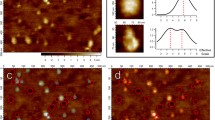Abstract
Under most microscopes, the fluorescent signals emitted from biological structures, such as vesicles, as well as the signals from single molecules will appear as small puncta, which contribute to a Gaussian-like distribution. Accurate segmentation of these spots will fundamentally affect our interpretation of a specific biological progress. Because of the complicated backgrounds in images, many algorithms fail to identify all of the interesting signals; the tremendous amount of time required for algorithms to process large datasets can also decrease their utility. Here, we introduce an excellent robust detection method based on the machine learning algorithm AdaBoost, which outperforms threshold-based segmentation, wavelets, and FDA under most situations. We also provide a GPU/multi-core CPU implementation of this algorithm; this implementation accelerates the algorithm approximately 10- and 7-fold acceleration compared with a single CPU implementation. The great reduction of time should make this method a promising candidate in the processing of large datasets. Furthermore, we demonstrate the use of our algorithm on true fluorescent micrographs, and the results show that machine learning-based detection methods outperform the four other previously reported methods.






Similar content being viewed by others
References
Huet S, Karatekin E, Tran VS et al (2006) Analysis of transient behavior in complex trajectories: application to secretory vesicle dynamics. J Biophys 91:3542–3559
Li CH, Bai L, Li DD et al (2004) Dynamic tracking and mobility analysis of single GLUT4 storage vesicle in live 3T3-L1 cells. Cell Res 14:480–486
Sezgin M (2004) Survey over image thresholding techniques and quantitative performance evaluation. J Electron Imaging 13:146–168
Otsu N (1975) A threshold selection method from gray-level histograms. Automatica 11:23–27
Vincent L (1993) Morphological grayscale reconstruction in image analysis: Applications and efficient algorithms. IEEE Trans Image Process 2:176–201
Soille P (2003) Morphological image analysis: principles and applications. Springer-Verlag New York, Inc
Sadler BM, Swami A (1999) Analysis of multiscale products for step detection and estimation. IEEE Trans Inf Theory 45:1043–1051
Olivo-Marin JC (2002) Extraction of spots in biological images using multiscale products. Pattern Recognit 35:1989–1996
Mallat SG (1989) A theory for multiresolution signal decomposition: the wavelet representation. IEEE Trans Pattern Anal Mach Intell 11:674–693
Viola P, Jones M (2001) Rapid object detection using a boosted cascade of simple features. In Proceedings, IEEE Conference on Computer Vision and Pattern Recognition 1:511–518
Viola P, Jones M (2001) Robust real-time object detection. Int J Comput Vis 4:34–47
Jiang S, Zhou XB, Kirchhausen T et al (2007) Detection of molecular particles in live cells via machine learning. Cytom Part A 71:563–575
Smal I, Loog M, Niessen W et al (2009) Quantitative comparison of spot detection methods in live-cell fluorescence microscopy imaging. Proc IEEE International Symposium on Biomedical Imaging: From Nano to Macro ISBI 1178–1181
Freund Y, Schapire RE (1996) Experiments with a new boosting algorithm. In Proceedings of the Thirteenth International Conference 96:148–156
Lienhart R, Maydt J (2002) An extended set of haar-like features for rapid object detection. In Proceedings of the International Conference. Image Process 1:900–903
Smal I, Loog M, Niessen W et al (2010) Quantitative comparison of spot detection methods in fluorescence microscopy. IEEE Trans Med Imaging 29:282–301
Papageorgiou CP, Oren M, Poggio T (1998) A general framework for object detection. In Proceedings of the Sixth International Conference on Computer Vision, pp 555–562
Freund Y, Schapire RE (1995) A desicion-theoretic generalization of on-line learning and an application to boosting. In Proceedings 2nd European Conference on Computational Learning Theory, Springer. 905:23–27
Freund Y, Schapire R, Abe N (1999) A short introduction to boosting. J-Jpn Soc Artif Intell 14:771–780
Rappoport JZ, Zhou XB, Kirchhausen T et al (2008) Dynamics of dynamin during clathrin mediated endocytosis in PC12 cells. PLoS One 3:e2416
Acknowledgements
This work was supported by the National Natural Science Foundation of China (31130065, 31100615).
Conflict of Interest
The authors declare that they have no conflict of interest.
Author information
Authors and Affiliations
Corresponding author
About this article
Cite this article
Liu, B., Feng, W., Xu, T. et al. A machine learning-based method to detect fluorescent spots and an accelerated, parallel implementation of this method. Chin. Sci. Bull. 59, 3573–3578 (2014). https://doi.org/10.1007/s11434-014-0385-4
Received:
Accepted:
Published:
Issue Date:
DOI: https://doi.org/10.1007/s11434-014-0385-4




